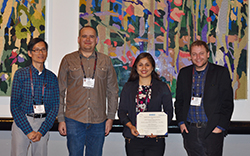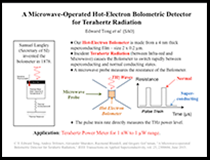 |
|
|
| SMA News and Events: 2016 | ||||
|
November 30, 2016
SMA Talk: Jonathan Henshaw (Liverpool John Moores University): "The Kinematics of the Star-Forming ISM: Environmental Tests of Star Formation Theory"
ABSTRACT: The conversion of gas into stars (and subsequent feedback) is one of the fundamental baryonic processes shaping the visible Universe. Despite its fundamental importance, we do not yet fully understand the physics at any scale of this process. Classical theories credit density as the key variable controlling star formation, leading to claims of a universal critical density for star formation. An alternative view is that density is merely the tip of the iceberg; that the formation processes of stellar systems are intimately linked to the dynamics of their natal environment. In this talk I will outline my approach to tackling this problem - targeting the key discriminating factor between models: the dynamics of molecular gas. There are two immediate challenges to this: i) the dynamics of stellar birth sites are complex; ii) techniques commonly used to describe them are often incapable of dealing with such complexity. I will begin by presenting a case study of the gas kinematics in the inner 250pc of the Galaxy; the Central Molecular Zone (CMZ). The CMZ is a particularly dynamic environment, and with extreme ISM properties it offers an important window into understanding star formation under extreme conditions. I will present our systematic approach to quantifying the kinematics, which has enabled us to infer the 3-D gas structure of the CMZ, and discuss how this may be critical for understanding both the formation of giant molecular gas clouds and individual stellar systems in this environment. My goal in the next three years is to expand this to a comprehensive, multi-scale understanding of the physical processes controlling star formation across a range of different environments, thereby testing theories of star formation to their limits. To achieve this goal, information of the gas kinematics on the size scales of individual forming stars is required. I will outline the integral role the SMA will play in reaching this goal, linking our understanding of star formation from galactic to protostellar scales.
November 21, 2016
Press Release:A Stellar Circle of Life
A snapshot of the stellar life cycle has been captured in a new portrait from NASA's Chandra X-ray Observatory and the Smithsonian's Submillimeter Array (SMA). A cloud that is giving birth to stars has been observed to reflect X-rays from Cygnus X-3, a source of X-rays produced by a system where a massive star is slowly being eaten by its companion black hole or neutron star. This discovery provides a new way to study how stars form. Photo: Cyg X-3's Little Friend Movie: Cygnus X-3s's Little Friend Viewed via space.com
October 29, 2016
SMA Event: SMA Science in the Next Decade
News Release
The Aacademia Sinica Institute for Astronomy and Astrophyics hosted a workshop on "SMA Science in the Next Decade", October 27-28, 2016. This workshop provided a forum for astronomers from the SMA collaboration and user community to promote, discuss, and elaborate on science opportunities with an upgraded wideband SMA (wSMA) that aims to process 32 GHz in two polarizations, from two receiver bands simultaneously. There were 86 registered participants, including 54 from Taiwan, 16 from SAO, and 16 from elsewhere around the world. A lively program of 21 invited talks and 3 discussion sessions focused on the impact of new wSMA capabilities on a wide range of science topics, from comets to the high redshift universe. The breadth of the program underscored the importance of high angular resolution millimeter and submillimeter observations in modern astrophysics. Also discussed were technical issues, large observing projects, and the broader context of other facilities operating at these wavelengths, including ALMA, IRAM/NOEMA and JCMT. An additional 14 shorter contributed talks and 10 posters, mostly from younger scientists, described recent science results. Everyone also enjoyed a tremendous traditional Chinese banquet at a nearby restaurant. The intellectual content of the formal program is captured in the presentations posted on the conference web pages. At least as important, the numerous breaks and shared meals enabled informal conversations throughout the workshop to conduct science, and to develop and enhance new scientific collaborations. Thanks to all of the organizers for a very successful meeting. ASIAA Conference Website Group Photo Courtesy of ASIAA
September 22, 2016
Shirin Montazeri wins first place in the Best Student Paper Prize
News Release: 2016 Applied Superconductivity Conference
Shirin Montazeri, a student at UMass Amherst, has won first place in the Best Student Paper Prize at the 2016 Applied Superconductivity Conference held in Denver earlier this month for the work she has done in the Receiver Lab at SAO. The winning paper is: A 220-GHz Compact SIS Receiver Module Utilizing a Broadband High-Gain Ultra-Low-Power IF Amplifier, Shirin Montazeri, Paul Grimes, Edward Tong, and Joseph Bardin.

Pictured left to right: Edward Tong, Paul Grimes, Shirin Montazeri, Joseph Bardin
August 2016
SMA Science in the Next Decade, October 27-28, 2016
SMA Event: Workshop
SMA observations have resulted in new insights into a wide variety of astrophysical phenomena, from protoplanetary disks to high redshift galaxies. The much larger international Atacama Large Millimeter/submillimeter Array (ALMA) is now in routine operation at millimeter and submillimeter wavelengths. To maintain a leading role in the ALMA era, the SMA project has embarked on an ambitious, staged, strategic upgrade to dramatically improve its sensitivity and observing speed. The new wideband SMA -- the wSMA -- will be ideally suited to spectral line surveys and studies of submillimeter sources in the time domain, as well as a wealth of other applications. This workshop will provide a forum for astronomers from the SMA collaboration and user community to promote, discuss, and elaborate key science cases for wSMA observations in the next decade. The workshop will also facilitate the forging of collaborations to help realize these new science opportunities.
August 25, 2016
Massive, short-lived stars may still form like the Sun
News Release: Astronomy Magazine
"Submillimeter Array in Hawaii and the Karl G. Jansky Very Large Array in New Mexico to look at G11.92-0.61 MM1, a proto O-type star around 11,000 light years away at least 30 times the mass of the Sun."
April 21, 2016
Paul Yamaguchi receives Smithsonian Unsung Hero for 2016
News Release
Paul is the Microwave Electronics Technician at the Maunakea Summit. He installs and maintains the fiber optics transmission and IF/LO systems. We congratulate Paul for his tireless efforts to make the SMA successful!
January 12, 2016
Call for SMA Science Observing Proposals
SMA Event
The SMA is currently accepting proposals for the 2016A observing semester (16 May 2016 - 15 Nov 2016) from principal investigators from the worldwide astronomical community. The proposal deadline is 04 February 2016, 16:00 EST (US) [04 February 2016, 11:00 HST (Hawaii) / 05 February 2016, 05:00 CST (Taipei)].
January 12, 2016
A Microwave-Operated Hot-Electron-Bolometric Power Detector for Terahertz Radiation
SMA Event: Secretary's Research Prize for 2014
Dr Edward Tong is one of the recipients of the Secretary's Research Prizes for 2014 which recognizes excellence in research by the Smithsonian Institution's employees.

|
||||
|
|